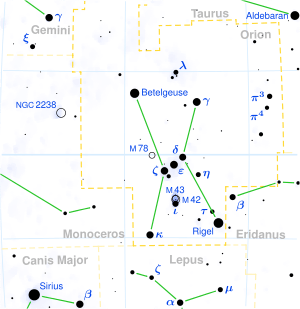56 Orionis
| Observation data Epoch J2000 Equinox J2000 | |
|---|---|
| Constellation | Orion |
| Right ascension | 05h 52m 26.43854s[1] |
| Declination | 1° 51′ 18.4958″[1] |
| Apparent magnitude (V) | 4.76[2] |
| Characteristics | |
| Spectral type | K1.5IIb[3] |
| U−B color index | +1.46[4] |
| B−V color index | +1.38[4] |
| Astrometry | |
| Radial velocity (Rv) | +11.56[5] km/s |
| Proper motion (μ) | RA: -7.16[1] mas/yr Dec.: -8.24[1] mas/yr |
| Parallax (π) | 2.59 ± 0.30[1] mas |
| Distance | approx. 1,300 ly (approx. 390 pc) |
| Absolute magnitude (MV) | -3.14[2] |
| Details | |
| Mass | 6.4[6] M☉ |
| Luminosity | 3473[2] L☉ |
| Surface gravity (log g) | 0.91[7] cgs |
| Temperature | 4,295[7] K |
| Metallicity [Fe/H] | -0.07[7] dex |
| Rotational velocity (v sin i) | 3.5[8] km/s |
| Other designations | |
| Database references | |
| SIMBAD | data |
56 Orionis is a class K1.5IIb[3] (orange bright giant) star in the constellation Orion. Its apparent magnitude is 4.76[2] and it is approximately 1260 light years away based on parallax.[1]
It has one reported companion, B, with magnitude 13.5 and separation 42.9".[9]
References
- 1 2 3 4 5 6 Van Leeuwen, F. (2007). "Validation of the new Hipparcos reduction". Astronomy and Astrophysics. 474 (2): 653. arXiv:0708.1752. Bibcode:2007A&A...474..653V. doi:10.1051/0004-6361:20078357. Vizier catalog entry
- 1 2 3 4 Anderson, E.; Francis, Ch. (2012). "XHIP: An extended hipparcos compilation". Astronomy Letters. 38 (5): 331. arXiv:1108.4971. Bibcode:2012AstL...38..331A. doi:10.1134/S1063773712050015. Vizier catalog entry
- 1 2 Hoffleit, D.; Warren, W. H. (1995). "VizieR Online Data Catalog: Bright Star Catalogue, 5th Revised Ed. (Hoffleit+, 1991)". VizieR On-line Data Catalog: V/50. Originally published in: 1964BS....C......0H. 5050. Bibcode:1995yCat.5050....0H.
- 1 2 Mallama, A. (2014). "Sloan Magnitudes for the Brightest Stars". The Journal of the American Association of Variable Star Observers. 42: 443. Bibcode:2014JAVSO..42..443M. Vizier catalog entry
- ↑ Famaey, B.; Jorissen, A.; Luri, X.; Mayor, M.; Udry, S.; Dejonghe, H.; Turon, C. (2005). "Local kinematics of K and M giants from CORAVEL/Hipparcos/Tycho-2 data". Astronomy & Astrophysics. 430: 165. arXiv:astro-ph/0409579. Bibcode:2005A&A...430..165F. doi:10.1051/0004-6361:20041272.
- ↑ Tetzlaff, N.; Neuhäuser, R.; Hohle, M. M. (2011). "A catalogue of young runaway Hipparcos stars within 3 kpc from the Sun". Monthly Notices of the Royal Astronomical Society. 410: 190. arXiv:1007.4883. Bibcode:2011MNRAS.410..190T. doi:10.1111/j.1365-2966.2010.17434.x. Vizier catalog entry
- 1 2 3 Earle Luck, R. (2014). "Parameters and Abundances in Luminous Stars". The Astronomical Journal. 147 (6): 137. Bibcode:2014AJ....147..137L. doi:10.1088/0004-6256/147/6/137.
- ↑ De Medeiros, J. R.; Mayor, M. (1999). "A catalog of rotational and radial velocities for evolved stars". Astronomy and Astrophysics Supplement Series. 139 (3): 433. arXiv:astro-ph/0608248. Bibcode:1999A&AS..139..433D. doi:10.1051/aas:1999401. Vizier catalog entry
- ↑ Mason, Brian D.; Wycoff, Gary L.; Hartkopf, William I.; Douglass, Geoffrey G.; Worley, Charles E. (2001). "The 2001 US Naval Observatory Double Star CD-ROM. I. The Washington Double Star Catalog". The Astronomical Journal. 122 (6): 3466. Bibcode:2001AJ....122.3466M. doi:10.1086/323920. Vizier catalog entry
This article is issued from
Wikipedia.
The text is licensed under Creative Commons - Attribution - Sharealike.
Additional terms may apply for the media files.
